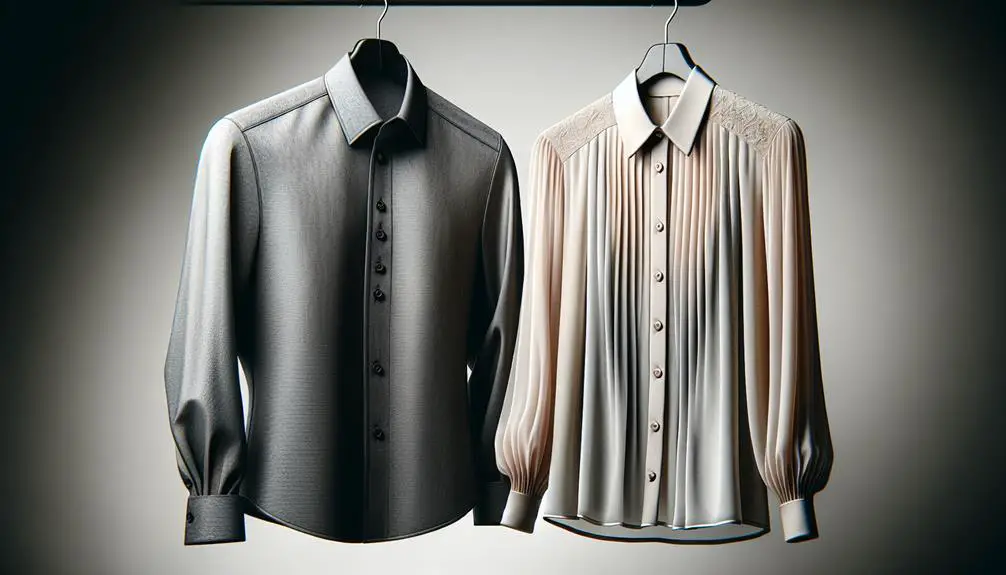As the saying goes, 'The devil is in the details.' When it comes to distinguishing between a shirt and a blouse, subtle nuances can make all the difference. From the way they fall on the body to the intricate design elements, each piece tells a unique story.
But what truly sets them apart? Let's untangle the threads and explore the distinct characteristics that define these wardrobe staples.
Table of Contents
Key Takeaways
- Shirts feature vertical button closures and structured collars, while blouses may have hidden buttons and elegant collar variations.
- Blouses use luxurious fabrics like silk, chiffon, or lace for sophisticated occasions, contrasting with shirts' everyday materials like cotton.
- Shirts have a figure-hugging fit with tailored silhouettes, while blouses offer a draped style and looser silhouette for comfort.
- Blouses are formal with intricate details like lace or pleats, ideal for parties or office settings, while shirts are casual for everyday wear.
Button Placement
When comparing shirt and blouse styles, the placement of buttons plays a significant role in distinguishing between the two garments. Shirts typically feature buttons on the right side for closure, while blouses may have fewer buttons, often hidden under a fabric placket for a seamless appearance. Button-down shirts usually have a vertical row of front buttons, providing complete closure, whereas blouses may opt for partial button fronts or decorative buttons, deviating from the traditional full button-down style of shirts.
Moreover, collar styles also contribute to differentiating between shirts and blouses. Shirts tend to have more standardized collar options such as button-down, straight, or spread-away collars. On the other hand, blouses offer a broader range of collar styles like Peter Pan, tie, Chelsea, wing, or shawl collars, adding to their versatility and aesthetic appeal. Understanding these nuances in button placement and collar styles can help in identifying whether a garment is a shirt or a blouse accurately.
Fabric Variation
Moving from the discussion of button placement to fabric variation, the choice of materials plays a crucial role in distinguishing between shirts and blouses.
Blouses often feature delicate fabrics like silk or chiffon, giving them a luxurious feel that sets them apart from shirts. These delicate fabrics contribute to the formal and elegant appearance of blouses, making them ideal for more sophisticated occasions.
On the other hand, shirts typically utilize lightweight materials such as cotton or polyester, emphasizing comfort and durability for everyday wear. The fabric selection is key in defining the distinction between shirts, known for their casual appeal, and blouses, favored for their sophistication and femininity.
Understanding the fabric variations between shirts and blouses can help in choosing the right garment for the occasion, as the fabric used greatly influences the overall look and feel of the clothing piece.
Style Differences
Let's talk about the distinctive style differences between shirts and blouses.
Focusing on fit and silhouette, neckline and collar variations, and sleeve lengths. These aspects play a significant role in defining the overall look and feel of each garment.
Understanding these key differences can help you choose the perfect piece for any occasion.
Fit and Silhouette
In comparing the fit and silhouette of shirts and blouses, one can notice distinct differences that cater to varying style preferences and body shapes.
- Shirts are typically more figure-hugging, especially around the waist and chest, accentuating the body's curves.
- Blouses, on the other hand, offer a more draped style, gathering at the waist and flowing upwards for a softer, more relaxed appearance.
- The fit of a shirt is designed to follow the natural contours of the body, emphasizing a tailored and structured look, while blouses provide a looser and forgiving silhouette that enhances comfort and movement.
These contrasting styles in fit and silhouette allow individuals to choose between a more form-fitting shirt or a flowy blouse based on their personal style and body shape preferences.
Neckline and Collar
Blouses showcase a variety of intricate neckline designs that range from Peter Pan to tie, Chelsea, wing, or shawl collars, emphasizing their feminine and versatile appeal. These collar styles add a touch of elegance and sophistication to the blouse, offering a more delicate and refined look compared to the structured collar styles commonly found in shirts.
Shirts, on the other hand, often feature button-down, straight, or spread-away collar styles, creating a more tailored and structured appearance. The neckline designs in blouses allow for a range of options, from subtle and dainty to bold and eye-catching, enhancing the overall aesthetic of the garment.
Sleeve Length
When comparing the sleeve lengths of shirts and blouses, the styles diverge in their approach to design and versatility.
- Blouses offer a range of sleeve lengths, such as short, three-quarter, and long sleeves, providing options for different occasions and styles.
- Shirts typically stick to standard sleeve lengths like short or long sleeves, with fewer variations compared to blouses.
- Sleeveless blouses are favored for warmer weather or formal events, exuding a chic and sophisticated look that's distinctive from traditional shirt designs.
Blouses often showcase intricate details like bell sleeves, ruffled cuffs, pleats, flounces, or lace, enhancing their aesthetic appeal and allowing for more diverse styling options compared to the more structured and traditional sleeves found on shirts.
Formality Levels
Typically, the formality level of a garment can be easily distinguished by the material used and the design details incorporated. When comparing shirts and blouses, it becomes evident that blouses lean towards the formal end of the spectrum, while shirts tend to exude a more casual vibe.
Blouses, crafted from luxurious materials like silk or chiffon, elevate their formality, making them ideal for upscale events or professional settings. On the other hand, shirts commonly utilize materials such as cotton or polyester, which contribute to a more relaxed and informal aesthetic.
The design elements further accentuate this contrast, with blouses often featuring intricate details like lace or pleats, enhancing their elegance and sophistication. In contrast, shirts usually boast simpler constructions, aligning with a more straightforward and everyday style.
Understanding these distinctions in formality levels between shirts and blouses can guide your outfit choices, ensuring you're appropriately attired for any occasion.
Silhouette Variances
As we shift our focus to silhouette variances between shirts and blouses, it becomes apparent that the way these garments drape and fit plays a pivotal role in distinguishing their overall aesthetic and style.
- Structured and Tailored Silhouette: Shirts are known for their structured and tailored silhouette, often featuring seams and darts that create a more defined shape around the body, particularly at the waistline.
- Billowy Silhouette: On the other hand, blouses typically gather at the waist and expand upwards, resulting in a billowy silhouette that offers a more relaxed and flowy fit compared to shirts.
- Femininity and Movement: The silhouette of blouses tends to be more feminine, emphasizing comfort and movement. This billowy style allows for ease of motion and a sense of airiness that's distinct from the sleek and polished look of shirts.
Understanding these silhouette variances is essential in choosing the right garment to suit the occasion and desired style.
Detailing Distinctions
When comparing shirts and blouses, it's essential to pay attention to the detailing distinctions that set them apart. From the types of fabrics used to the various style variations, these details play a crucial role in determining the overall look and feel of the garment.
Additionally, factors like fit and silhouette can further highlight the differences between shirts and blouses, making it easier to choose the right piece for any occasion.
Fabric Types Comparison
Crafting a distinct style statement, the fabric choices between shirts and blouses showcase notable differences in texture, drape, and overall aesthetic appeal.
- Blouses often feature delicate fabrics like silk, chiffon, or lace, exuding elegance and femininity.
- Shirts commonly utilize lightweight materials such as cotton, linen, or polyester for a structured and versatile appearance.
- The choice of fabric in blouses contributes to their dressier and more formal aesthetic compared to the material used in shirts.
These distinctions in fabric types not only impact the look and feel of the garments but also play a significant role in determining their overall style and functionality. By understanding these fabric variances, one can better appreciate the unique characteristics that define shirts and blouses.
Style Variations Overview
Exploring the array of style variations between shirts and blouses reveals a wealth of distinctive design elements that set these garments apart.
Blouses offer a wider range of styles, such as lace, asymmetrical, off-the-shoulder, and high-necked designs, while button-down shirts typically come in fitted, tailored, or classic cuts.
Blouses often feature more intricate elements like panels or ruffles, adding a touch of sophistication. Recent trends have seen the introduction of open-fronted jacket blouses, blending modernity with tradition.
Collar styles in blouses vary greatly, with options like Peter Pan, tie, Chelsea, wing, or shawl collars, providing diverse choices for different looks. Each collar type in both shirts and blouses has a unique origin story, contributing to the overall design and aesthetic of the garment.
Fit and Silhouette
Discussing the fit and silhouette of shirts and blouses unveils key distinctions that shape the overall look and feel of these garments.
- Shirts are crafted with a tailored waist for a structured silhouette, while blouses offer a looser and more forgiving fit.
- Blouses feature wider waistlines, creating a relaxed silhouette, whereas shirts maintain a more defined shape.
- Details such as pleats and lace are commonly found on blouses, adding a feminine and decorative touch unique to this garment category.
Understanding these fit and silhouette differences can help in choosing the right piece to complement various styles and occasions effectively. Whether opting for the tailored elegance of a shirt or the relaxed charm of a blouse, these subtle details play a significant role in fashion choices.
Occasion Suitability
When considering the suitable attire for different events, the choice between a blouse and a shirt depends on the desired level of formality and the occasion's nature. Blouses are often the preferred option for parties, office settings, or special occasions due to their dressier and more formal appearance. Their elegance and versatility make them suitable for a wide range of events where a more sophisticated look is required.
On the other hand, shirts are commonly chosen for casual or everyday occasions, offering a more relaxed and informal style. Their practicality and comfort make them ideal for everyday wear and laid-back settings. By understanding the nature of the occasion and the level of formality needed, one can make an informed decision between a blouse for a dressy event or a shirt for a more casual outing. Selecting the appropriate garment ensures that you're both comfortable and appropriately dressed for the occasion at hand.
Frequently Asked Questions
What's the Difference Between Shirt and Blouses?
The distinction between shirts and blouses lies in their fit, detailing, and formality. Shirts offer a structured look, while blouses are often looser with decorative elements. These differences make blouses more suitable for formal occasions compared to shirts.
Why Is a Woman's Shirt Called a Blouse?
As a woman, I've pondered why a shirt is called a blouse. The term "blouse" evokes elegance and grace, reflecting femininity. It's more than a garment; it's a symbol of sophistication and style for women.
What Is the Difference Between a Dress and a Blouse?
When comparing a dress and a blouse, the key distinction lies in their structure. A dress is a full outfit, while a blouse is a versatile top. Dresses offer a complete look, while blouses can be mixed and matched with various bottoms.
What Is the Difference Between a Blouse and a Tunic?
Wearing a tunic is like painting a canvas; it offers creativity and comfort. Tunics are longer, flowing tops, while blouses are more structured and typically shorter. Both bring flair to outfits in their own unique ways.
- The History and Evolution of Chamois Fabric - June 22, 2025
- Chamois Fabric on Wikipedia: What You Need to Know - June 22, 2025
- How to Pronounce Chamois Fabric Correctly - June 22, 2025






